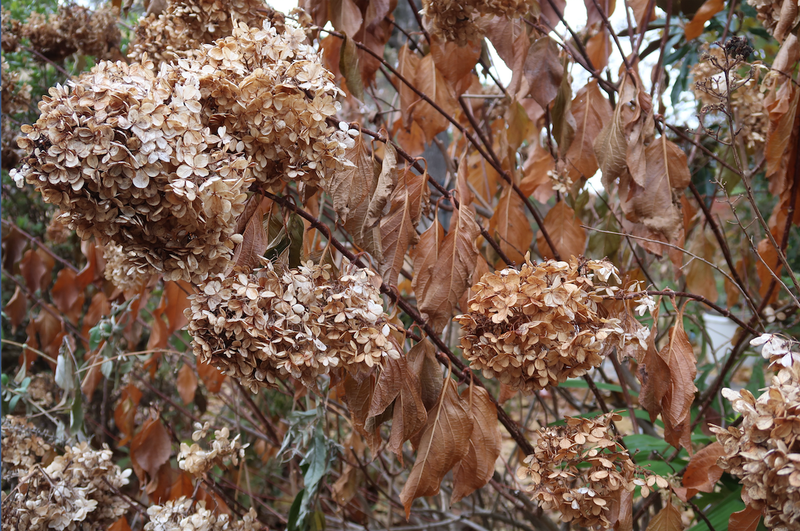We definitely had a taste of winter already. Record lows across the state for November don't portend of nice things to come, and many are worried that we are in for a doozy of a winter, but who knows what will happen. I have read predictions of warmer than normal, dryer than normal, colder than normal, and wetter than normal, so take your pick. One of them has to be right. Just know what to do should any of them happen.
• We have seen some winter damage already on some plants. I have had reports of brown or burned leaves on some evergreens including azaleas, mahonia and Indian hawthorn. I have had reports of rosemary looking really bad, and some of the winter annuals and vegetables took an early hit -- particularly Swiss chard and some of the mustards. Many are questioning why. It's because we had an earlier-than-normal hard frost, and a lower-than-normal temperature for a longer-than normal-period of time. Many of the plants were not quite ready to go dormant yet. We may see the foliage lingering longer than normal on some of the deciduous shrubs that had not yet put on their fall colors. Those leaves will eventually fall but it could take a while. The winter vegetables and ornamental chard and mustards already are bouncing back. For evergreen shrubs or herbs, don't prune off any damage until spring. If we do have more winter weather, this damaged foliage can help protect the rest of the plant. Wait for spring to assess any permanent damage and address it then.
• Continue with garden cleanup. All of the summer plants are now history, and the perennials need to be cut back. There is still time to plant winter annuals, including pansies, violas, dusty miller, flowering kale and cabbage. If you want to have blooms this winter, then buy annuals with flowers on them. Small, nonflowering winter annuals usually won't start blooming much until spring, so opt for larger, flowering plants now. We will have periodic warm days off and on throughout the winter. When we do, fertilize the winter annuals to keep them looking their best. You can also continue to plant spring flowering bulbs this month.
• The holiday season is upon us and gardening often takes a back seat to other endeavors in December. The signs of the season are everywhere. Poinsettias have hit the stores and come in a huge range of sizes and colors. Keep the plants in bright light and a cool location. Keep them evenly moist, but avoid too much water. With just minimal care they can shine long after the rest of the decorations are put up.
• Christmas decorations seem to go up earlier and earlier every season, and Christmas trees are one of the mainstays of the decorations. According to the American Christmas Tree Association 79% of all households will have some type of Christmas tree, but only 20% of them will be a fresh tree. Artificial trees have steadily dominated. For those of you in that 20%, choose a fresh tree, or better yet, go to a Christmas tree farm and cut your own. When you get a pre-cut tree, make a fresh cut on the bottom and let it soak in a bucket of warm water before you mount it in the stand. Try to keep drying heating vents from blowing directly on the tree and keep the stand full of water. Keep all open flames away from live or artificial trees.
• If you are using greenery from your yard for decoration, make sure you take your cuttings from your plants where it won't be too noticeable. Fresh greenery lasts longest outside in the cool weather, but will add fragrance and color indoors. Just realize that it dries out quickly.

TERM OF THE MONTH — ABSCISSION LAYER
Deciduous leaves are just with us for one growing season. They sprout in the spring, grow to their full potential size during the late spring and work at producing food via photosynthesis during the growing season. As the days get shorter and the temperatures get lower, the chlorophyll begins to break down allowing the natural pigment of the foliage to shine through. One other process also begins to happen. An abscission layer is formed at the base of the petiole (small stem that holds a leaf on the tree). Once the abscission layer is fully formed, the result is that the petiole breaks away from the stem and the leaf falls. Abscission is a natural process that is most closely aligned with the seasons, but can also occur when a plant is stressed from environmental conditions, diseases or insects. It also occurs on evergreen plants, but not on every leaf or pine needle every year -- some shed and some stay attached.
This year, you may be noticing more than normal dead leaves staying attached to trees and shrubs. In particular many Japanese maples, crape myrtles, deciduous magnolias, along with deciduous shrubs such as hydrangeas, spirea, and forsythia had not yet fully formed their abscission layers before the hard frost came. The result is that the leaves are still attached, even though they are dead. Some are falling when we have windy days, but some may persist throughout the winter until new growth pushes them off. It may not be the prettiest sight in the garden, but don't try to physically remove them; just ignore them, and they should get back to normal soon.
Read Janet Carson's blog at arkansasonline.com/planitjanet.
HomeStyle on 11/30/2019
